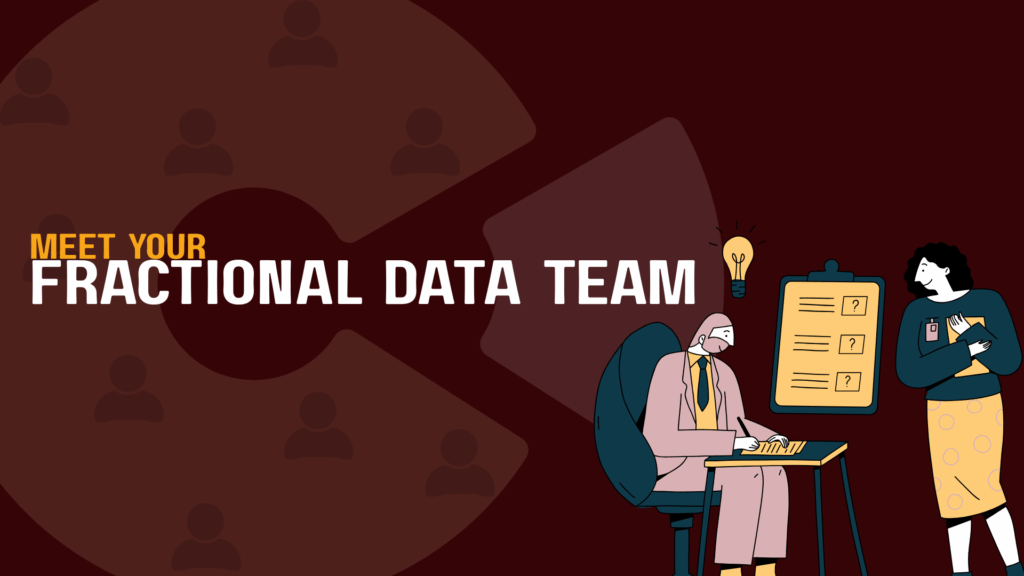If you’re a small-to-mid-size business (SMB), you’ve probably run into this dilemma:
You‘re collecting data from your tools — marketing, product, sales, support — but you don’t really have time, or people, to turn it into actionable insights.
An internal data team of analysts, engineers, scientists could do the work, but the cost, time, and overhead of a full-time team don’t make sense for non-enterprise businesses.
The good news is there’s a better option. A more strategic, cost-effective way to unlock real value from your data, without hiring, onboarding, and maintaining an in-house team.
Why collecting data is expensive
Many SMBs are stuck at data collection. They have raw exports, spreadsheets, and maybe some partially built-out BI tools.
But what they lack is the full infrastructure, the right roles, and the ongoing commitment needed to translate raw data into actionable insights that drive strategy.
The consequences?
- Important business questions go unanswered.
- Decision-making becomes reactive rather than proactive.
- Growth opportunities are missed because insights come too late.
- Without clear visibility, things like churn, customer satisfaction, or operations inefficiencies go unspotted until they hit the bottom line.
In short: data never reaches its potential of being a powerful business asset.
Hiring a full internal team isn’t always the answer
You might think: “If it’s that important, we’ll just hire an analyst, maybe a data engineer, and get the job done.” But that often isn’t the best answer because:
- Salaries alone are high (analysts, engineers, and scientists don’t come cheap).
- Recruiting, onboarding, and management also take time and resources.
- Then you have infrastructure: warehouses, pipelines, servers, visualization tools — each with maintenance, security, and integration hurdles to jump
- And importantly: many companies don’t need full-time data staffing all year. Demand for certain kinds of analysis ebbs and flows. It isn’t every week you need new dashboard building or complex data engineering. Once your core dashboards and scorecards are created and automated, the necessary maintenance work isn’t full-time.
Often going the full-time internal data team route is impractical, inefficient, and leaves you with less capital available to act on data insights the team uncovers.
What a Fractional Data Team Gives You: The Best of Both Worlds
This is where a fractional data team steps in. It’s purposefully structured so you get expertise, flexibility, and cost-efficiency. Here’s what you gain:
| Benefit | What it means for your business |
| Lower overall cost | You pay only for the time and expertise you need — no full-time salaries, health insurance, or other long-term staffing overhead. |
| Speed to value | Since the fractional team is already up and running (analysts, engineers, scientists are in place), you don’t waste months hiring, training, or building infrastructure from scratch. |
| Access to senior expertise | You get pros who’ve worked with multiple businesses and tools, who know best practices and can avoid common pitfalls. |
| Scalability & flexibility | Month-to-month billing with no contracts or minimum. Bring us on to build a single custom reporting dashboard or keep us engaged for ongoing support. |
| Focused work on what matters | Custom dashboards, KPI scorecards, reporting aligned with your business model — not generic templates. Clear insights to help operational leads, COOs, founders decide where to focus. |
Real-World Scenarios
BlinkMetrics customers are excited about how new data insights have impacted their businesses . Check out their stories.
Here are a few other ideas for the kinds of answers companies like yours might get from a fractional data team:
- Marketing Attribution & Optimization
You want to know which channels are actually driving revenue. The fractional team builds unified dashboards that pull data from your ad platforms, CRM, payment processor, and website to give visibility into cost, ROI, and where to double down. - Customer Success & Churn Prevention
Instead of waiting until customers cancel, you get early warning signals: usage drop, support tickets rising, etc. Then you act. You don’t need a full-time data scientist for that; you need timely reports and good analysis. - Operational Efficiency
Maybe your inventory, fulfillment, or support processes are leaking money. A fractional team can build reports to show what’s taking too long, what’s costing too much, or where bottlenecks exist.
Getting Started: What to Expect
When you partner with our fractional data team, we will start with a discovery call where you can share your data problems, reporting goals, and analytics gaps.
Coming out of that call, you will get a data plan tailored to your business needs and goals.
We will connect to your data sources and pull that information into custom automated dashboards.
Our team teaches you how to use your new tools so they become part of your workflow.
Share feedback, request new features, add additional dashboards, and continue to refine as you grow. We are with you throughout the journey.

Is a Fractional Team Right for You?
You don’t need to accept either/or: letting data go to waste or bearing the full cost of hiring an internal team. Fractional data teams offer a powerful middle path — delivering the insights and operational clarity you need, without the long-term commitment or expense.
The fractional data team route is a popular and effective option if:
- You have data, or data sources, but you’re not fully leveraging them.
- You need insights but don’t want to commit to a full team
- You value speed: you want real insight quickly, not months of setup.
- Your data needs fluctuate (some months/quarters heavy, others less so).
- You want professional-grade dashboards, reporting, and analysis, not just ad hoc Excel exports.
If you’re ready to unlock the value buried in your data, get visibility across your operations, and make smarter decisions without blowing your budget, a fractional data team might be exactly what your business needs.





